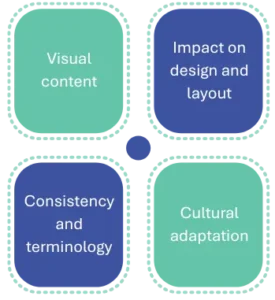In the world of international marketing, brochures remain one of the most effective tools for presenting a brand, product, or service. But creating a brochure in your local language is not enough if your company plans to expand into other markets. To truly connect with your target audience, you need professional brochure translation services that do more than just convert words from one language to another. The tone, design, and even visual elements should be adapted to reflect the cultural expectations of each market.
At Linguaserve we specialize in marketing translation, particularly digital formats, and we help companies bring their communication strategies to a global level. We ensure that brochures are just as effective in Madrid, Milan, or Tokyo. In this article you will find everything you need to know before starting a brochure translation project, whether in print or digital form: what it costs, how long it takes, what types of brochures can be translated and the key points you should keep in mind.
How much does it cost to translate a brochure?
The most common question companies ask is, “How much does it cost to translate a brochure?” The answer depends on several different variables. In most cases, brochure translation is billed by the word, but the final price can vary widely depending on the following factors:
- Language combination: translating from English into Spanish is generally less expensive than into Japanese or Finnish, due to the availability of qualified translators for each language pair.
- Volume of text: a three-page brochure will not cost the same as a 40-page catalogue.
- Complexity of the content: technical brochures—for example, in the medical or automotive sectors—require specialist translators, which can increase costs.
- Integration into the layout: when a brochure is created in professional design software such as InDesign, additional work may be required to adapt the layout and adjust the translated text.
- Additional services: many projects also require editing, proofreading or multilingual desktop publishing (DTP).
In the specific case of travel brochure translation, the work often goes beyond language alone: cultural references, units of measurement and even currencies are frequently adapted so that they remain relevant to international travelers.
Indicative ranges: the translation of a standard brochure of about 2,000 words from Spanish into a common European language can cost between €150 and €400, depending on the factors listed above.
How long does it take to translate a brochure?
Time is just as important as price. Many companies need their brochures ready before a trade fair, a product launch, or a seasonal campaign. So how far in advance should you plan for brochure translation?
- Average pace: a professional translator can translate around 2,000 words per day. For a 10,000-word brochure, you should allow at least a week, plus extra time for revision and layout adjustments.
- Multiple languages: if you need translations into ten different languages, it is possible to assign several translators to work simultaneously. However, the coordination and final review may extend the delivery by a few days.
- Design adjustments: languages such as German or French often require more space than English; this text expansion means additional time is needed for multilingual desktop publishing.
- Urgent projects: express services are available, but they usually involve an extra fee.
As a general guideline, if you need a multilingual brochure for an international event, it is advisable to plan with your translation provider in order to allow sufficient time for all the necessary steps.
What types of brochures can be translated?
Almost any type of brochure can be translated, although the approach will vary depending on the document and its intended purpose. The most common categories include:
- Corporate brochures: present the company, its values, and services. These require precision along with creative adaptation.
- Product catalogues: include technical specifications and detailed descriptions, where consistency of terminology is vital.
- Tourism brochures: in travel brochure translation, persuasive style and cultural sensitivity are essential to engage international visitors.
- Event brochures: programs, schedules, or guides for conferences and trade fairs. Delivery times are especially critical here.
- Educational brochures: used by universities, training centers, or NGOs, with a tone that balances formality with promotional appeal.
- Interactive digital brochures: designed for online environments, these often include buttons, links, or animations, all of which must be localized and tested to ensure smooth functioning in every language.
Each type brings its own challenges. For example, tourism brochures frequently use idiomatic expressions or references to local traditions that cannot be translated literally, they require cultural localization.
Key factors in brochure translation services
In addition to cost and time, there are several essential aspects that determine the effectiveness of a translated brochure.
1.- Visual content
-
- Images: these sometimes contain text (maps, infographics, signage) that must also be translated.
- Charts and tables: if they contain labels or captions, they must be localized so they remain clear to readers.
- Logos and slogans: logos usually remain unchanged, but slogans integrated into them may require creative adaptation.
2.- Impact on design and layout
Translation has a direct effect on the design:
- Text expansion or reduction: some languages (such as German or French) require more space, while others (such as Chinese or Finnish) need less.
- Typography: languages with different scripts (Arabic, Russian, Japanese) may require changes in font or even right-to-left text direction.
- Page count: changes in text length can even alter the total number of pages in the brochure.
For this reason, many companies combine translation with multilingual desktop publishing to ensure that the final brochure retains both the appearance and the functionality of the original.
3.- Consistency and terminology
Terminology management is particularly important in technical brochures or catalogues. Using glossaries and translation memories helps guarantee consistency across all product names and brand terms.
4.- Cultural adaptation
Translating words alone is not enough. Cultural references, expressions and even colors may need to be adjusted so the message is convincing in every market. For digital or interactive brochures, multilingual SEO is also essential. This includes optimizing titles, descriptions, and keywords so that the content achieves visibility in international search engines.
A brochure is often the very first impression a potential client has of your brand in a new market. Investing in high-quality brochure translation services ensures that your message is understood, persuasive and culturally relevant.
At Linguaserve, we bring together linguistic expertise, marketing vision, and multilingual desktop publishing services so that your brochures communicate the same message in every language. If you want brochures that do more than simply translate words, and instead truly connect with each international market, we can help you develop a comprehensive strategy for translation and localization.



